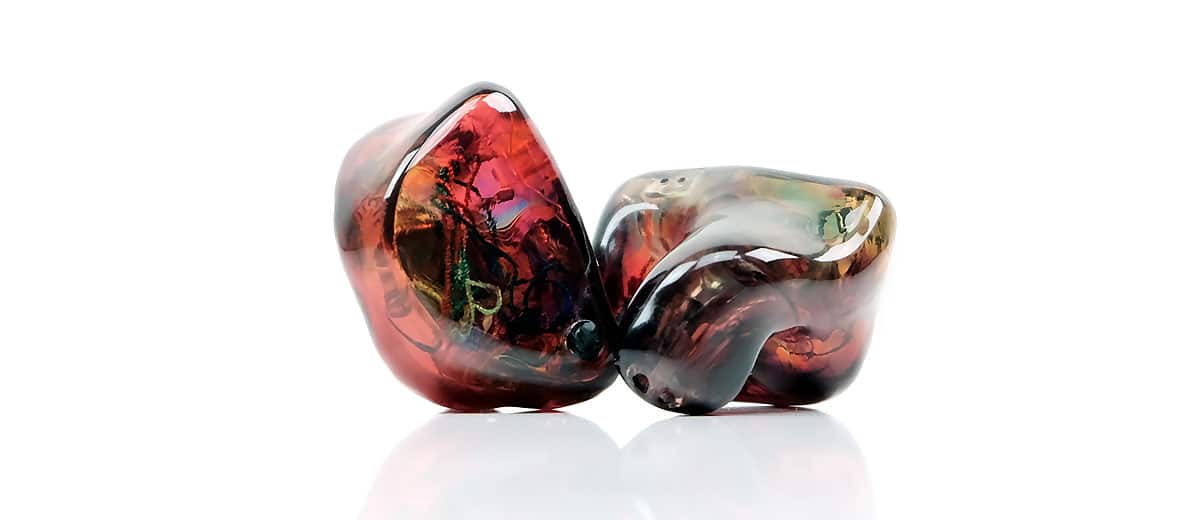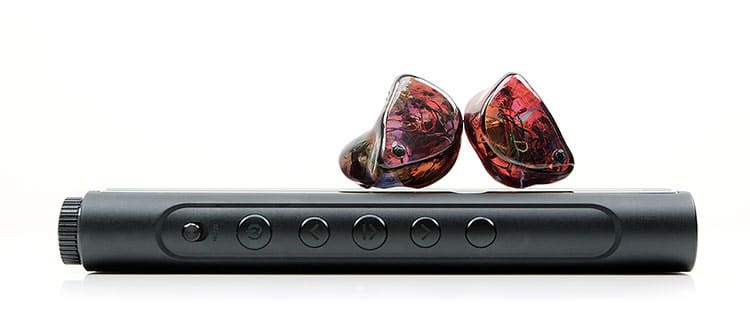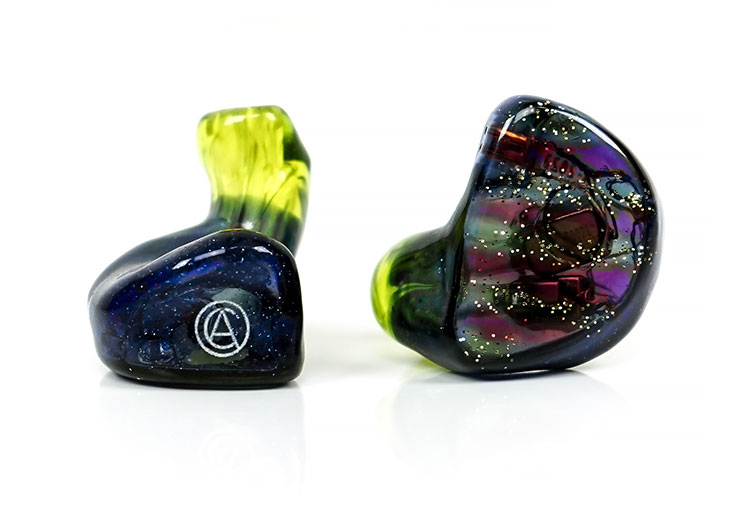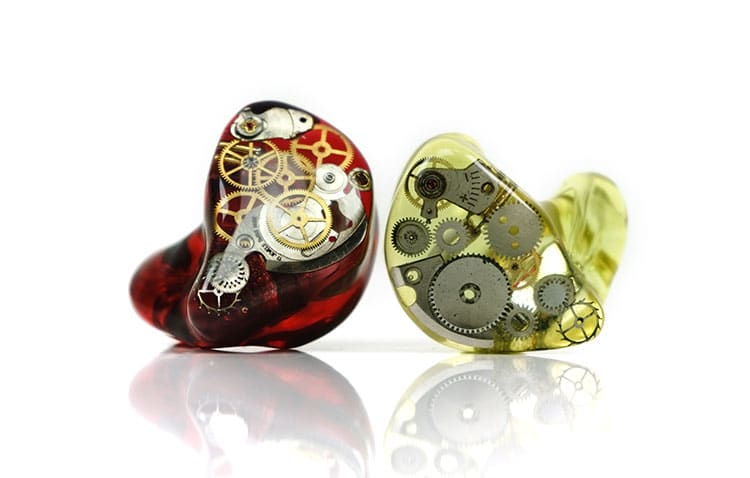Lime Ears psi Synergy
Efficiency
The Lime Ears psi is rated at 46Ω and 109dB SPL so not the most sensitive of monitors out there but not that hard to drive either with most DAPs more than comfortable in a low-gain unbalanced setting.
It’s SPL is just low enough to avoid being overly reactive to higher the normal noise floors from portable amps and DACs. I tend to hear that around 112dB upwards on other more sensitive IEM such as the EE Zeus or Campfire Audio’s Solaris. The impedance is also high enough to avoid skew from high output impedance sources such as the HiBy R6 and Shanling’s M2s.
It also has some surprisingly good results for low noise using the R2R2000 Red from Hifiman. I was expecting this to be a high noise low useable current pairing but in actual fact going unbalanced the noise floor is very low with up to 9-10 volume steps useable. The balanced option will bring in some pop and clicks and a bit of hiss but nothing atrocious. Useable current drops to about 7 with the psi in balanced mode.
Pairings
It depends on what you want out of the psi in terms of pairings. If it is for excellent clarity and an easy option to go balanced or unbalanced then the likes of the iBasso DX220 with AMP1 MKII and the FiiO M15 will suit the psi perfectly. Both have an expansive airy top-end that ensures the psi never sounds too relaxed or dark and with a solid emphasis on detail and articulation.
However, both are not bass killers with the psi. The DX200 will sound a shade wetter and more rounded in its tone with the psi than the cleaner and more neutral-sounding M15. Even with the bass switch on the M15 is more to the polite side.
If you are wondering why not the M11 at more than half the price, it does do well and it is a low noise floor pairing also. However, compared to the M15 with the psi its sounds a little veiled or softer in the mids which is what I do not want to hear with the psi’s relaxed presentation.
If you need a bit more snap on the psi low-end and perhaps some additional warmth then the Cayin N6ii/E02 combo, as well as the Lotoo PAW 6000 DAPs, offer more slam than the first two mentioned players, even with the bass switch turned off.
Of these two, it is the Cayin N6oo/E02 that delivers the better separation helping to tease out a wider soundstage and a bit more complexity to the psi presentation. The PAW 6000 is a shade more forward and center focused but it does offer a bit more treble presence and can sound the more energetic of the two sources with the psi.
Smartphone Life
I would not really go for a jacked smartphone pairing with the psi, at least not the Samsung Note 9 which sounded shrill and hard-edged for treble and too soft on the low-end.
I had no issues with loudness but the output on this phone is not the most sublime with the psi. You would be better off with something like the PAW S1 dongle that is a lot more generous on the low-end girth and a smoother treble from the psi. With the bass switch on, the psi/PAW S1 pairing is quite potent for a triple BA driver monitor.
Select Comparisons
Custom Art FIBAE 3
From €525
Technical
The FIBAE 3 was released back in early 2018 and suffice to say I thought it was an excellent custom IEM. The price is also extremely competitive and I would say, knowing those two companies, it is a bit of friendly competition between these two offerings.
Like the psi the FIBAE 3 is a triple BA configuration in a very stylish custom design. Both companies really do not charge huge amounts for their different custom options which is very appealing to me. However, beyond that, both monitors have very contrasting setups.
The FIBAE 3 big pitch is the flat impedance technology that renders impedance mismatching FR skew moot. That allows CA to drop the FIBAE 3 right down to under 8Ω and 110dB SPL and avoid problems with the likes of the HiBy R6.
The psi has a much higher impedance rating at 46Ω and is less efficient at 109dB SPL. Skew is not an issue either but it does need more power and current to volume match and is the harder to drive. Further, the psi offers the bass switch control which gives it 2 unique signatures, something which the FIBAE 3 does not have.
Bass Off
The FIBAE 3 and psi with the bass switch turned off follow a generally similar forgiving sound signature with a slight low-end tilt upwards, some warmth in the mids, and a forward vocal. What separates them is the level of low-end bloom and treble influence.
Here the FIBAE 3 sounds a little more attenuated offering a wetter top-end and not quite as much headroom. Notes are more rounded and percussion is smoother but they do not have as much presence or bite as the psi.
The psi sounds a little more forward in the treble and that seeps down in the mids timbre so you get more of a contrast in vocal and instrumental notes. Vocals can sound a little more energetic as a result but also a shade sharper.
The additional bass bloom or weight is not a huge difference but noticeable enough on the psi switch down. It is just enough to create a good balance with the enhanced treble contrast so you could argue its more u-shaped than the FIBAE 3’s more relaxed signature.
Bass On
With the bass switch on the psi takes a big leap away in terms of tuning bias. You get a lot more bloom and mid-bass warmth but vocal are a shade louder also and perceivably more forward in the mix.
In fact, it is all about the bass, timbral warmth, vocal body, and some nuanced treble contrast with the psi bass on. It is a powerful and fun-sounding if a little less complex then when turned off. There is not a huge amount of room left for intricate instrumental notes or any phrasing in between so it is entirely suitable for modern pop and EDM.
Here is where the FIBAE 3 might appeal more to those who want something with a bit more control but would still like to retain that even harmonic bias in their voicing preferences.
Gaudio Clairden
€759.65
Technical
We recently reviewed the Clariden along with its sibling the Nair. Both are universal monitors as opposed to the custom design of the psi, however, both use 3 BA driver configurations much like the psi. I chose the Clariden for this comparison because its presentation is more in line with the psi than the reference Nair sound though it is lacking the psi bass switch so not as flexible.
Visually both are hugely different. The Clariden is a beautiful minimalist machined aluminum with a silver anodized finish whereas the psi is a lighter acrylic unique custom design. The psi will be the more comfortable of the two and isolate better due to its custom fit. The Clariden is the smaller and more robust or durable of the two monitors.
The Clariden is rated at 17Ω but the SPL is not listed in the specs. Compared to the psi’s 46Ω and 109dB SPL in neutral mode the Clariden sounds the marginally louder at similar volumes, however, with the additional bass boost turned on, the psi becomes subjectively louder. However, the degree of difference overall is slight so I wouldn’t place the Clariden SPL too far away from the psi’s.
Both use a 0.78mm 2-pin configuration, however, the Gaudio steps it up a few levels over the generic 4-wire OFC of the psi with a Satin Audio Hyperion. This is a 1.2m 28AWG wire using SP-OCC Pure SPC Type 2 Litz geometry, a nylon damping core, and audio grade Cardas Audio Quad Eutectic Solder. Given the minor price difference, you can squeeze in a $99 EA Maestro for the psi and even it up a bit more for my money.
Bass Off
This is a very competitive comparison as both monitors are aiming for the same effect from their respective presentations. However, at the same time, their emphasis and timbre create a very different feeling or vibe.
This reminds of a SET amp versus a solid-state resistor amp in terms of how both would approach ‘musicality’. The psi in the role of the SET or tube amp with its sweeter tone through the mids, though not without some nice clarity and contrast in the forward treble tuning. It has some nice bass weight but it is still a comparatively relaxed and smooth sounding into the lower-mids with that mid-bass rise and longer sub-bass decay.
The Clariden is the solid-state and the cooler sounding more energetic of the two presentations. It has a bit more sub-bass quantity but less mid-bass warmth and a cleaner midrange timbre as a result. Vocals have a sweeter more euphonic tone on the psi and an airier cleaner quality on the Clariden.
Treble is similarly weighted perhaps a bit more forward on the Clariden and leaner but that could be perceived as it has less of a mid-bass warmth creeping into the mids timbre to balance it out.
Bass On
With the psi bass switch on the overall bass quantity is much bigger than the Clariden. That elevation stretches right from the sub-bass, through to the lower-mids so not only voluminous but also very much the warmer of the two monitors.
Mids timbre becomes richer, vocals have even more body but treble has slightly less presence than with the bass switch off. It makes the Clariden vocals sound a little thin and more prone to natural sibilance but that’s a comparative stance rather than sibilant per se.
The Clariden, almost by default, becomes the hi-fidelity choice of the two presentations despite the fact Gaudio pitch it as the musical alternative to the Nair. It cannot compete with the psi coloration on the low-end.
However, it’s spacing and bass layering it tighter and better defined to be fair and it does have a better balance of the two presentations in terms of clarity and separation. The bass off psi is the better comparison of these two if we are aiming for audiophiles, the bass-on is just for pure fun with less emphasis on hi-fidelity.
Avara AV3
$310
Technical
The AV3 was our Bang For Buck custom IEM back in 2018 and for good reason. The performance at the price is excellent. Both the psi and AV3 are custom IEMs, and both are triple BA driver designs. The key difference, however, is the bass switch on the psi which will give it a distinct advantage with 2 sound profiles instead of the AV3’s one.
The design of both are actually on par for me. I think Avara at the time had a bit more limitations in their 3D printing process but still, the classic clock face was clean and well implemented. The Cosmic Swirl is a bit more unique for me on the psi but the finishing on both is on par with zero bubbles or funky bits hanging off.
Both have a dual-bore thicker nub nozzle though the width of the AV3 nozzle is just slightly wider. The level of comfort and isolation is good on the AV3 but the psi is just a bit more secure with very much the superior passive isolation. I am not sure if that is the fitting which has a shade more pressure or the type of acrylic used for the body.
Both use 0.78mm 2-pin terminations and they do seem to use similar OFC 4-wire 1.2m braided-type cables in a black PVC jacket. They both benefit sonically from simple aftermarket cable upgrades.
Bass Off
Even with the bass switch turned off the psi is by far the ‘juicer’ of these two triple driver monitors. That means more of a u-shaped response, heavier low-end in terms of quantity and extension. The AV3 has some nice mid-bass warmth and can sound punchier at times but the sub-bass sounds comparatively rolled-off in comparison so not quite the same level of power.
On the plus side, that frees up some room on the mids which is where the AV3 is at its strongest. It can sound a little more mid-centric by comparison with a more forward vocal presence but also not the same contrast or percussion sparkle with less lower-treble emphasis.
Timbre is different with the AV3 showing off a more euphonic midrange tone, more rounded in the vocal and instrumental note with less percussion presence and bite. The psi has more of a planted fundamental and solidity to low-pitching instruments and an upper midrange with a cleaner tone.
I would say there is also a little less upper treble energy in the AV3 and not quite the same headroom. You get more of an intimate or closer sound with the AV3 as a result compared to the superior depth and height with the psi.
Bass On
The Psi immediately shows off a heck of a lot more low-end quantity and an enhanced mid-bass bloom and warmth compared to the Avara. The AV3 cannot compete in terms of quantity but it does sound a lot more evenly balanced and the more open sounding of the two as a result.
Vocals have a better presence on the AV3 whereas the psi is further back. However, in deference, the psi has a slightly better level of perceived detail so things such as vocal pronunciation sound cleaner and better defined. You still get plenty of treble ‘tickle’ on the psi bass on mode and some good contrast which does help with the clarity levels from the upper mids onwards.
Our Verdict
Lime Ears have always created enjoyable sound signatures with a bit of a twist and the psi does nothing to buck that trend. Like the Aether R and Model X, the psi has that bass switch technology and it does create two very identifiable and engaging sound signatures. You can change it up from sweet and pleasurable to powerful and warm with a flick of a switch.
Having a choice is always good, and an attractive feature that picky customers will pick up. Particularly at this competitive price point where there are a lot of competition. Having it in a custom format is just the icing on the cake. The design is unique and interesting but it is really the comfort and pressure levels that set this one apart from some of the other competing builds.
Just do me a favor and budget another $100 and grab the EA Maestro cable if you can. It makes a huge difference over that stock 4-wire black cable in terms of dynamic range and treble clarity. You owe it to yourself as the psi has a lot of excellent potential indeed.
Lime Ears psi Specifications
- 3 precision balanced armature drivers
- 3-way passive crossover design
- Sensitivity: 109 dB/mW
- Impedance: 46 Ohm (@1000Hz)







